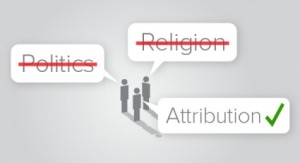 Most likely you spend most of your waking hours working. If you’re really lucky, your co-workers are close confidants who you talk about everything with, except religion, politics – and if you’re a marketer – attribution.
Most likely you spend most of your waking hours working. If you’re really lucky, your co-workers are close confidants who you talk about everything with, except religion, politics – and if you’re a marketer – attribution.
While marketing attribution as a concept is fairly straight-forward, there’s a lot of confusion about attribution, and a lot of heated debate around which attribution models make the most sense for any given business. My goal is to make attribution part of every marketer’s vocabulary and practice.
At a recent Allocadia knowledge sharing session, I gave a presentation about how attribution is a lot like different religions and political systems. My team loved the analogy. If you’re like most savvy marketers who are still sorting out attribution and how the different models work, here’s my summary.
Marketing Attribution Defined
“Attribution is the science of assigning credit or allocating dollars from a sale to the marketing touch points that a customer was exposed to prior to their purchase.”
Sounds simple enough, right?
Not quite.
Let’s take a look at an example customer buying process relevant to most B2B organizations. The customer:
- Does a Google search.
- Meets us at a tradeshow (and we meet another contact from the same company).
- Watches a demo video on our website.
- Is sent an eBook offer.
- Has a demo with a sales rep, who closes the deal for $ 400K.
That’s a lot of touch points. So, which touch point pushed the customer to make the purchase? The answer is complicated.
Attribution Models Are Like Religions and Political Systems
In our example, there are several different attribution models that can be used to allocate credit. Let’s look at the similarities between these models, and religions and political systems.
- First Touch and Last Touch
The entire $ 400K credit could be given to the campaign that brought the lead in the door (first touch). After all, there wouldn’t be any conversation without it. Or, the entire credit could be attributed to the last touch. If that final step hadn’t occurred, the deal wouldn’t have happened. These two models are a little like a dictatorship. You pick and choose what you give credit to, but there is a blind spot to other influences. First and last touch are a starting point in attribution, but not a great one.
- Multi-Touch Even Weighted
With this model, credit is distributed equally among every campaign element. This model is like socialism – no single campaign element is special and everyone gets equal credit.
- Multi-Touch Position-Based
In this model, more weight is given to the first and last touches, and remaining credit is distributed to the other campaigns. This approach is more democratic. All campaigns are acknowledged and given credit, but there is opportunity for individual efforts to shine.
- Time Decay
In the Time Decay model, the campaigns closest to the sale get most of the credit. You could think of this model as being a bit like Buddhism. One campaign component only contributed partially; the next campaign will be better, so credit is humbly deferred to the next touchpoint.
- Predictive
This next level of attribution modeling is akin to aristocracy. Like Plato’s Republic where educated and smart people rule, marketers build predictive models to give more credit based on past successful campaigns.
Let’s Get Real About Attribution
Just as there are many different ways of looking at the world, there are numerous ways to look at attribution. Although these approaches can be subjective, and there is good and bad in each, we do believe that each has value in of itself and should be part of your performance views.
We believe it’s better to start somewhere and work towards having a more complete view of your data by each model in order to get as many additional layers or lenses of insights as you can into the data. This is what facilitates having more informed and educated conversations about your performance data. In other words, seeing your data in different ways can help you to read between the lines and ask questions of your data that would not have been seen otherwise.
Furthermore, we recommend marrying a campaign-level with a top-down aggregate level approach (see “Going Above Attribution”). This view can also give you an additional layer of visibility helping you to make more informed decisions.
Allocadia software supports “above attribution views” as well as first touch and last touch, multi-touch even weighted, multi-touch position-based and time decay attribution. Customers can also add layers of sophistication to their model by including/excluding particular variables such as contact roles and responses.
With accountability being more expected than ever for how marketing dollars are being spent, now is the perfect time to get a handle on your investments and marketing performance management.
So, if attribution comes up in your next team meeting, don’t be shy to discuss it! Just keep an open mind. Be informed as to all the different ways it can be looked at and ensure that you are looking at it objectively and realistically as you mature. In other words, make sure that you don’t prescribe to one model but rather respect each and get a handle on each so you have layers of insight that help you make better decisions as to where to re-allocate.
Business & Finance Articles on Business 2 Community(37)
Report Post






